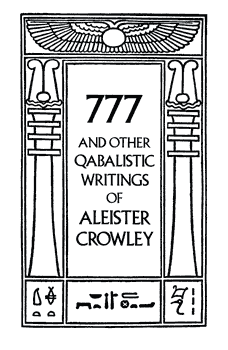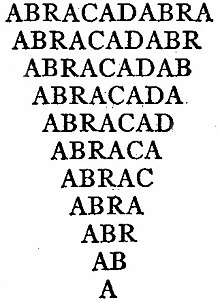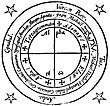A magical organization or magical order is an organization or secret society created for the practice of initiation into ceremonial or other forms of occult magic or to further the knowledge of magic among its members. Magical organizations can include Hermetic orders, esoteric societies, arcane colleges, and other groups which may use different terminology and similar though diverse practices.

Numerology is the belief in an occult, divine or mystical relationship between a number and one or more coinciding events. It is also the study of the numerical value, via an alphanumeric system, of the letters in words and names. When numerology is applied to a person's name, it is a form of onomancy. It is often associated with astrology and other divinatory arts.

Thelema is a Western esoteric and occult social or spiritual philosophy, as well as a new religious movement that was founded in the early 1900s by Aleister Crowley (1875–1947), an English writer, mystic, occultist, and ceremonial magician. Central to Thelema is the idea of discovering and following one's True Will, a unique purpose and calling that goes beyond ordinary desires. Crowley's system begins with The Book of the Law, a text he said was dictated to him by a non-corporeal entity named Aiwass. This foundational work lays out key principles, including the central axiom "Do what thou wilt shall be the whole of the Law". This principle emphasizes personal freedom and the pursuit of one's true path, while being guided by love and finding one's authentic purpose.

777 and Other Qabalistic Writings of Aleister Crowley is a collection of papers written by Aleister Crowley. It is a table of magical correspondences. It was edited and introduced by Dr. Israel Regardie, and is a reference book based on the Hermetic Qabalah.

Ceremonial magic encompasses a wide variety of rituals of magic. The works included are characterized by ceremony and numerous requisite accessories to aid the practitioner. It can be seen as an extension of ritual magic, and in most cases synonymous with it. Popularized by the Hermetic Order of the Golden Dawn, it draws on such schools of philosophical and occult thought as Hermetic Qabalah, Enochian magic, Thelema, and the magic of various grimoires. Ceremonial magic is part of Hermeticism and Western esotericism.

Thoth Tarot is an esoteric tarot deck painted by Lady Frieda Harris according to instructions from Aleister Crowley. Crowley referred to this deck as The Book of Thoth, and also wrote a 1944 book of that title intended for use with the deck.

The A∴A∴ is a magical organization established in 1907 by occultist Aleister Crowley. Its members are dedicated to the advancement of humanity by perfection of the individual on every plane through a graded series of universal initiations. Its initiations are syncretic, unifying the essence of Theravada Buddhism with Vedantic yoga and ceremonial magic. The A∴A∴ applies what it describes as mystical and magical methods of spiritual attainment under the structure of the Qabalistic Tree of Life, and aims to research, practise, and teach "scientific illuminism". A∴A∴ is often held to stand for Argenteum Astrum, which is Latin for Silver Star; however, see the section on Name below.
The Bornless Ritual, also known as the Preliminary Invocation, is a ritual with a long history and deep roots in various occult traditions, particularly within Western Esotericism. It is often associated with ceremonial magic, in which it has been generally used as an Invocation of the Knowledge and Conversation of the Holy Guardian Angel, since it was introduced as such by the Hermetic Order of the Golden Dawn. It is also called the "Headless Rite" or the "Invocation of the Bornless One".
Abrahadabra is a word that first appeared in The Book of the Law, the central sacred text of Thelema. Its author, Aleister Crowley, described it as "the Word of the Aeon, which signifieth The Great Work accomplished." This is in reference to his belief that the writing of Liber Legis heralded a new Aeon for mankind that was ruled by the god Ra-Hoor-Khuit. Abrahadabra is, therefore, the supreme magical formula of this new age. It is not to be confused with the Word of the Law of the Aeon, which is Thelema, meaning "Will".
Margaret E. Ingalls, known by her pen name Nema Andahadna or simply Nema, was an American occultist, ceremonial magician, and writer known for her magical writings about the Ma'atian current.
Aiwass is the name given to a voice that the English occultist and ceremonial magician Aleister Crowley reported to have heard on April 8, 9, and 10 in 1904. Crowley reported that this voice, which he considered originated with a non-corporeal being, dictated a text known as The Book of the Law or Liber AL vel Legis to him during his honeymoon in Cairo.
In the religion of Thelema, it is believed that the history of humanity can be divided into a series of aeons, each of which was accompanied by its own forms of "magical and religious expression".
Within Thelema, the Great Work is the spiritual endeavor aimed at realizing one's True Will and achieving a profound mystical union with the All. This path, crafted by Aleister Crowley, draws inspiration from Hermetic alchemy and the Hermetic Qabalah. The cornerstone of Thelema is the Book of the Law, received by Crowley in 1904 through a communication with the entity Aiwass. This text became the central scripture, heralding a new Aeon for humanity and outlining the principles of Thelema.
Aleister Crowley was an English writer, not only on the topic of Thelema and magick, but also on philosophy, politics, and culture. He was a published poet and playwright and left behind many personal letters and daily journal entries. Most of Aleister Crowley's published works entered the public domain in 2018.

Magick, Liber ABA, Book 4 is a book by 20th-century occultist Aleister Crowley. It is widely considered to be his magnum opus.
In ceremonial magic, banishing refers to one or more rituals intended to remove non-physical influences ranging from spirits to negative influences. Although banishing rituals are often used as components of more complex ceremonies, they can also be performed by themselves. Banishing can be viewed as one of several techniques of magic, closely related to ritual purification and a typical prerequisite for consecration and invocation.

The Lesser Ritual of the Pentagram is a ceremonial magic ritual devised and used by the original order of the Golden Dawn that has become a mainstay in modern occultism. This ritual is considered by many to be a basic preliminary to any other magical work, so much that it was the only ritual, besides initiation rituals, taught to members of the Golden Dawn before they advanced to the Inner Order.
IPSOS, meaning "themselves", is the magical formula of the Aeon of Ma'at as transmitted by Nema Andahadna in her inspired magical work, Liber Pennae Praenumbra. It is used by the Horus-Maat Lodge and Kenneth Grant's Typhonian Order. According to Kenneth Grant, its initiated translation is "the same mouth".

Hermetic Qabalah is a Western esoteric tradition involving mysticism and the occult. It is the underlying philosophy and framework for magical societies such as the Golden Dawn, has inspired esoteric Masonic organizations such as the Societas Rosicruciana in Anglia, is a key element within the Thelemic orders, and is important to mystical-religious societies such as the Builders of the Adytum and the Fellowship of the Rosy Cross.
Therion (thēríon) is a deity found in the mystical system of Thelema, which was established in 1904 with Aleister Crowley's writing of The Book of the Law. Therion's female counterpart is Babalon, another Thelemic deity. Therion, as a Thelemic godform, evolved from that of "The Beast" from the Book of Revelation, whom Crowley identified himself with since childhood, because his mother called him that name. Indeed, throughout his life he occasionally referred to himself as “Master Therion” or sometimes “The Beast 666”. He wrote:
Before I touched my teens, I was already aware that I was THE BEAST whose number is 666. I did not understand in the least what that implied; it was a passionately ecstatic sense of identity.











